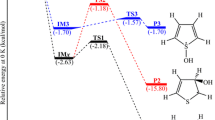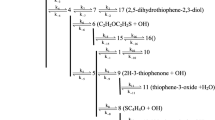Abstract
Electronic properties were correlated with observed reductive dechlorination pathways by unacclimated consortia for chlorinated phenols, dihydroxybenzenes, benzoic acids, and anilines. Molecular structures and properties were calculated using the semi-empirical Modified Neglect of Differential Overlap method at the Cornell Supercomputing Facility. Observed preferential positions for reductive dechlorination by unacclimated consortia correlate well with the largest negative value for the carbon-chlorine bond charge. Of 16 dechlorination pathways observed for unacclimated bacteria, the most negative carbon-chlorine bond charge correlated with 15 pathways.
This correlation between the observed dechlorination position and the parent compound's electronic properties is consistent with the observed reductive dechlorination of chlorophenols and chlorinated dihydroxybenzenes at the ortho position, and the meta dechlorination of chlorobenzoic acids. Net carbonchlorine bond charges also correlate with the preferred dechlorination position for two of three known chloroaniline pathways, suggesting preferential removal of chlorines from the ortho position of chloroanilines.
Similar content being viewed by others
Abbreviations
- CA:
-
chloroaniline
- CBz:
-
chlorobenzoic acid
- CC:
-
chlorocatechol
- CP:
-
chlorophenol
- DCA:
-
dichloroaniline
- DCBz:
-
dichlorobenzoic acid
- DCC:
-
dichlorocatechol
- DCH:
-
dichlorohydroquinone
- DCP:
-
dichlorophenol
- DCR:
-
dichlororesorcinol
- PCP:
-
pentachlorophenol
- TCA:
-
trichloroaniline
- TCBz:
-
trichlorobenzoic acid
- TCC:
-
trichlorocatechol
- TCH:
-
trichlorohydroquinone
- TCP:
-
trichlorophenol
- TCR:
-
trichlororesorcinol
- TeCA:
-
tetrachloroaniline
- TeCBz:
-
tetrachlorobenzoic acid
- TeCC:
-
tetrachlorocatechol
- TeCH:
-
tetrachlorohydroquinone
- TeCP:
-
tetrachlorophenol
- TeCR:
-
tetrachlororesorcinol
References
Boyd SA & Shelton DR (1984) Anaerobic biodegradation of chlorophenols in fresh and acclimated sludge. Appl. Environ. Microbiol. 47: 272–277
Bryant FO, Hale DH & Rogers JE (1991) Regiospecific dechlorination of pentachlorophenol by dichlorophenol-adapted microorganisms in freshwater, anaerobic sediment slurries. Appl. Environ. Microbiol. 57: 2292–2301
Gibson SA & Suflita JM (1986) Extrapolation of biodegradation results to groundwater aquifers: reductive dehalogenation of aromatic compounds. Appl. Environ. Microbiol. 52: 681–688
Goldblum A (1987) Improvement of the hydrogen bonding correction to MNDO for calculations of biochemical interest. J. Comput. Chem. 8: 835–849.
Hale DA, Rogers JE & Wiegel J (1990) Reductive dechlorination of dichlorophenols by nonadapted and adapted microbial communities in pond sediments. Microb. Ecol. 20: 185–196
Horowitz A, Suflita JM & Tiedje JM (1983) Reductive dehalogenation of halobenzoates by anaerobic lake sediment microorganisms. Appl. Environ. Microbiol. 45: 1459–1465.
Kohring G-W, Rogers JE & Wiegel J (1989) Anaerobic biodegradation of 2,4-dichlorophenol in freshwater lake sediments at different temperatures. Appl. Environ. Microbiol. 55: 348–353
Kuhn EP & Suflita JM (1989) Sequential reductive dehalogenation of chloroanilines by microorganisms from a methanogenic aquifer. Environ. Sci. Technol. 23: 848–852
Mikesell MD & Boyd SA (1985) Reductive dechlorination of the pesticides 2,4-D, 2,4,5-T, and pentachlorophenol in anaerobic sludges. J. Environ. Qual. 14: 337–340
Mikesell MD & Boyd SA (1986) Complete reductive dechlorination and mineralization of pentachlorophenol by anaerobic microorganisms. Appl. Environ. Microbiol. 52: 861–865
Struijs J & Rogers JE (1989) Reductive dehalogenation of dichloroanilines by anaerobic microorganisms in fresh and dichlorophenol-acclimated pond sediment. Appl. Environ. Microbiol. 55: 2527–2531
Suflita JM, Horowitz A, Shelton DR & Tiedje JM (1982) Dehalogenation: a novel pathway for the anaerobic biodegradation of haloaromatic compounds. Science 218: 1115–1116
Suflita JM & Miller GD (1985) Microbial metabolism in chlorophenolic compounds in ground water aquifers. Environ. Toxicol. Chem. 4: 751–758
Woods SL, Ferguson JF & Benjamin MM (1989) Characterization of chlorophenol and chloromethoxybenzene biodegradation during anaerobic treatment. Environ. Sci. Technol. 23: 62–68
Author information
Authors and Affiliations
Rights and permissions
About this article
Cite this article
Cozza, C.L., Woods, S.L. Reductive dechlorination pathways for substituted benzenes: a correlation with electronic properties. Biodegradation 2, 265–278 (1991). https://doi.org/10.1007/BF00114558
Received:
Accepted:
Issue Date:
DOI: https://doi.org/10.1007/BF00114558




